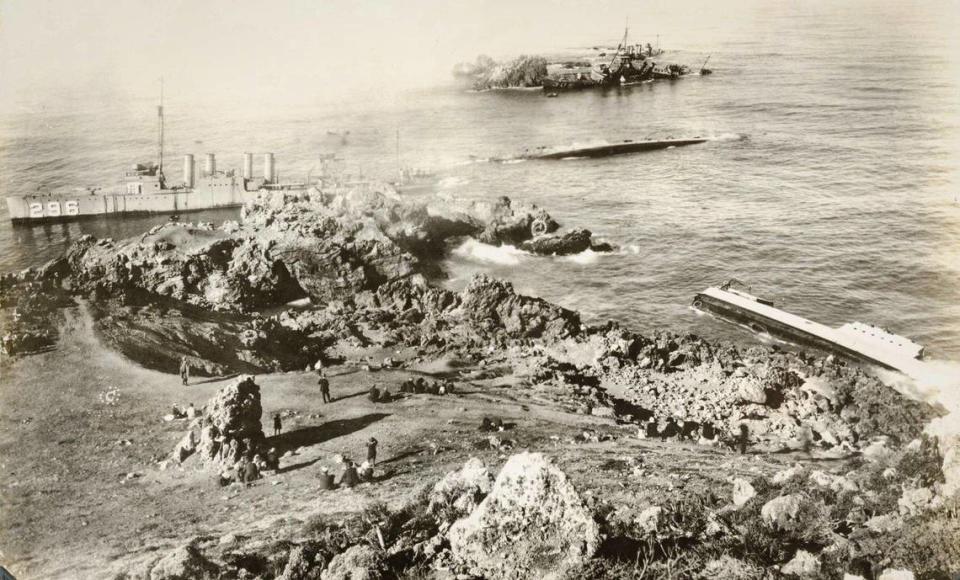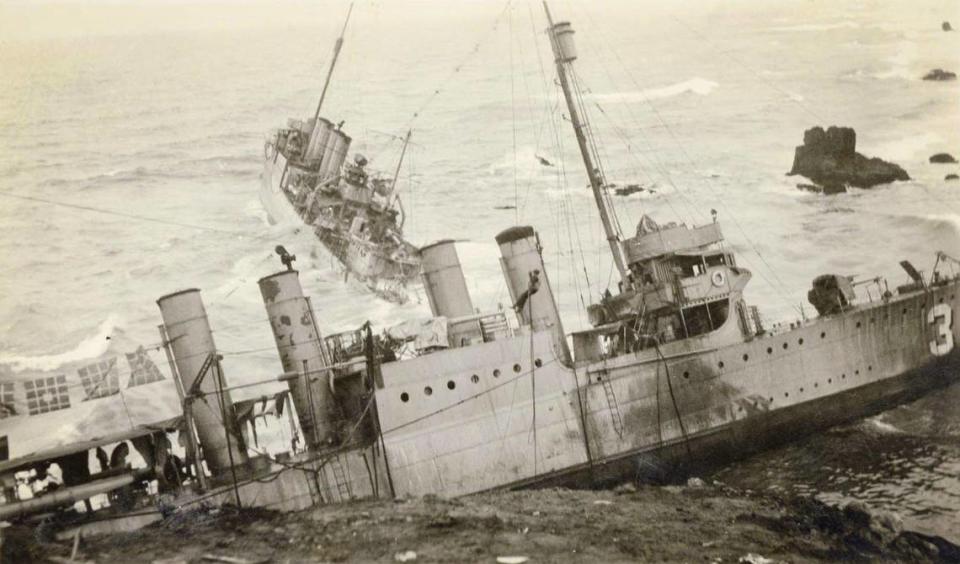Navigation error sent 9 ships crashing into rocks off Central Coast a century ago
It was an epic failure of navigation, and the U.S. Navy’s worst peacetime naval disaster.
On a foggy night a century ago, 14 destroyers of Squadron 11 made a 55-degree turn into what they thought was the Santa Barbara Channel.
They were actually a few miles away.
Rather than the new-fangled technology of radio direction finding, the captain of flagship USS Delphy relied on dead reckoning to plot his location — estimating the direction and distance traveled by compass heading and calculating speed against a clock.
Evidence later showed the Delphy led the vessels following it to their doom. The others were able to take corrective action that saved their vessels.
Ten minutes after the turn, nine destroyers crashed into the rocks off the coast at 20 knots — about 23 mph.
Seven of those destroyers sunk in 5 minutes, never return home to San Diego.
Two others were damaged, but able to back away.
A total of 23 sailors died on as a result of the disaster north of Point Conception on Sept. 8, 1923: three from the Delphy and 20 from the USS Young.
Initially, it was thought that many of the dead had been trapped inside the hull of the Young. Later, it was discovered they had been washed into the sea.
It took heroic efforts to save the almost 800 sailors who remained stranded amid crashing surf, as outlined in the book “Tragedy at Honda” by Charles A. Lockwood and Hans Christian Adamson.
The injured were taken by rail to hospitals in Santa Barbara and San Luis Obispo.
Sixteen sailors and two officers were tasked with standing watch over the wreck. They relied on local donations of food until the seas calmed and the Navy could supply them.
The Honda Point disaster was the largest peacetime loss of Navy ships in U.S. history
The monetary loss was estimated to be $13 million — roughly $233 million in 2023 dollars.
In addition to navigation errors and fog, contributing factors may have included a tsunami earlier in the month that had impacted waves and currents, as well as radio traffic related to the sinking of the mail ship Cuba near San Miguel Island. Everyone aboard the Cuba was saved.
In the aftermath of the disaster, Honda Point became a macabre tourist stop, with people bringing lunches to the area. It is now closed behind the fences of Vandenberg Space Force Base but Destroyer Rock is still marked on Google maps.
The San Luis Obispo Daily Telegram published several stories Monday Sept.,10, 1923, the first edition after the accident.

One known dead, 22 missing, as 7 ships pile up
Confusion of radio signals is blamed
Associated Press — SANTA BARBARA, Sept.10. — One dead, 22 missing of whom 19 are thought dead; three adrift on a life raft and possibly safe, and 13 injured in the hospital here is the record in human losses and serious injuries resulting from the disaster in which seven United States destroyers were piled on the rocks 75 miles north of this city Saturday night.
All vessels are believed a total loss although a navy tug and repair ship are standing by just at the edge of the tumbling breakers ready to render assistance if there is a possible chance.All the ships lie close in to the beach except the Woodbury and Fuller, but the water is shallow and the breakers cover a strip several hundred yards wide. The Young is a hopeless wreck, lying on her side, while the Delphy is broken up. The bottoms of tall the others are torn on the jagged rocks and their plight is hopeless. The surf has been heavy ever since the wreck and hour by hour the hulks of the warships have been driven further up into the sands.
The task of cutting through the hull of the young to release the bodies of nearly a score of men imprisoned there was begun this morning and it is thought that they will be recovered some time today. The bulk of the Young lies so close to the shore that the workers can almost step from the bluff to the tomb of the wreck victims.

Radio Signals Confused
All mystery as to the cause of the wreck has been cleared away in the opinion of the survivors of the wreck and seafaring men here, by the explanation that the navy ships were thrown more than 10 miles off their course by a confusion of radio signals.
Because of the wreck of the Pacific Mail liner Cuba on San Miguel island, off the coast nearly opposite the place where the destroyers met their doom, the radio operators on shore were trying to direct the course of the destroyer Reno to their assistance. The fog was so dense that the radio was the only guide.
The operators of the destroyer squadron, speeding along in the fog over a rough sea, picked up the signals intended for the Reno. The mistake was discovered and Arguello light station corrected the bearings for the destroyer fleet. The correction came about five minutes before the wreck. The ships changed their course but the correction came too late and the other ships piled up on the rocks and beach.
Seaman’s Death Dramatic
One of the most dramatic features of the wreck is the death of a seaman named Pearson or Pierson on board the Delphy. Blinded when the glasses he wore were broken and hurled overboard where he swallowed some crude oil, Pearson seems to have lost his reason, according to the statements of his comrades.
Two shipmates rescued him but in his delirium he fought them so hard that they could not get him ashore. They lashed him on board the ship. There he perished as the vessel broke in two before rescuers could get back to him.
Fisherman Is Hero
One of the heroes of the wreck is an Italian fisherman, Capt. G. Noceti of the fishing boat Breno de Roma of this city. With the aid of the two men who made up his crew, the fisherman took from the Woodbury and Fuller, the two destroyers lying farthest from the beach, 150 sailors and landed them safely on the beach. The skiff of the fisherman safely crossed the surf time and again. Had it not been for this Italian, it is thought that the loss of life would have been far heavier. One of the officers who was a witness of the work of Capt. Noceti declared that he should have a hero’s medal. And when he had removed the wrecked sailors to safety the fisherman returned to his nets. It was all in a day’s work.
Seafaring men point out that while the fisherman was plying back and forth through the surf, 11 destroyers lay offshore apparently helpless.


